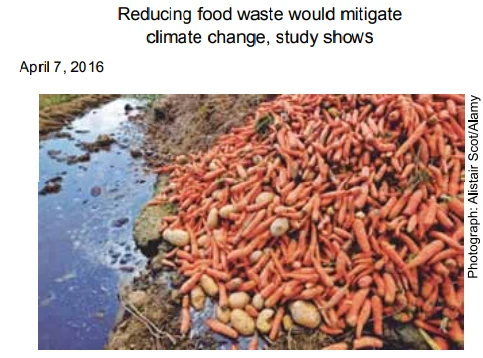Disciplina: Inglês 0 Curtidas
The text a) presents the findings of a study that - UNIFESP 2017

Reducing food waste around the world would help curb emissions of planet-warming gases, lessening some of the impacts of climate change such as more extreme weather and rising seas, scientists said on Thursday.
Up to 14% of emissions from agriculture in 2050 could be avoided by managing food use and distribution better, according to a new study from the Potsdam Institute for Climate Impact Research (PIK). “Agriculture is a major driver of climate change, accounting for more than 20% of overall global greenhouse gas emissions in 2010,” said co-author Prajal Pradhan. “Avoiding food loss and waste would therefore avoid unnecessary greenhouse gas emissions and help mitigate climate change.”
Between 30 and 40% of food produced around the world is never eaten, because it is spoiled after harvest and during transportation, or thrown away by shops and consumers. The share of food wasted is expected to increase drastically if emerging economies like China and India adopt western food habits, including a shift to eating more meat, the researchers warned. Richer countries tend to consume more food than is healthy or simply waste it, they noted.
As poorer countries develop and the world’s population grows, emissions associated with food waste could soar from 0.5 gigatonnes (GT) of carbon dioxide equivalent per year to between 1.9 and 2.5 GT annually by mid-century, showed the study published in the Environmental Science & Technology journal. It is widely argued that cutting food waste and distributing the world’s surplus food where it is needed could help tackle hunger in places that do not have enough – especially given that land to expand farming is limited.
But Jürgen Kropp, another of the study’s co-authors and PIK’s head of climate change and development, told the Thomson Reuters Foundation the potential for food waste curbs to reduce emissions should be given more attention. “It is not a strategy of governments at the moment,” he said.
(www.theguardian.com. Adaptado.)
The text
-
presents the findings of a study that analysed agriculture in China and India.
-
states that the more agriculture spreads, the less greenhouse gas will be emitted.
-
says that extreme weather can lead to crop losses and hunger.
-
proposes that agriculture should be expanded in order to preserve the environment.
-
establishes a relationship between food waste and climate change.
Solução
Alternativa Correta: E) establishes a relationship between food waste and climate change.
A alternativa E é a correta porque o texto claramente estabelece uma relação entre o desperdício de alimentos e a mudança climática. Ele menciona que a redução do desperdício de alimentos pode ajudar a diminuir as emissões de gases que contribuem para o aquecimento global, o que, por sua vez, poderia mitigar os efeitos das mudanças climáticas, como condições climáticas extremas e elevação do nível do mar. Essa conexão é enfatizada ao longo do texto, destacando como a agricultura, sendo uma grande responsável pelas emissões de gases de efeito estufa, poderia reduzir suas contribuições ao evitar a perda e o desperdício de alimentos.
As demais alternativas não refletem com precisão o conteúdo do texto. A opção A menciona um estudo específico sobre a agricultura na China e na Índia, mas o texto se refere a um estudo mais amplo que abrange a agricultura global e não se limita a esses dois países. A opção B sugere que a expansão da agricultura levaria a menos emissões de gases, o que não está alinhado com a argumentação apresentada; na verdade, o texto destaca que a agricultura é um dos principais responsáveis pelas emissões. A opção C menciona que o clima extremo pode causar perdas de colheitas e fome, mas essa ideia é apenas uma parte da discussão e não é o foco central do texto. A opção D sugere que a agricultura deveria ser expandida para preservar o meio ambiente, o que contradiz a proposta de que reduzir o desperdício de alimentos é uma abordagem mais eficaz para mitigar as emissões.
Portanto, a opção E é a mais apropriada, pois sintetiza a mensagem central do texto sobre como o desperdício de alimentos está intrinsecamente ligado ao aumento das emissões de gases de efeito estufa e, consequentemente, às mudanças climáticas.
Institução: UNIFESP
Ano da Prova: 2017
Assuntos: Interpretação Textual em Inglês
Vídeo Sugerido: YouTube